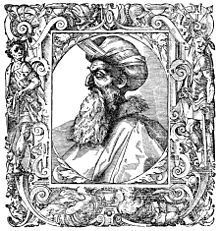Kait Bay

Al-Malik al-Ashraf Saif ad-Din Abu l-Nasr Kait-Bay (or Qayit-Bey ) az-Zahiri ( Arabic الملك الأشرف سيف الدين أبو النصر قايت باي الظاهري, DMG al-Malik al-Asraf Saif ad-Dīn Abū n-Naṣr Qāʾit / Qāyit-Bey aẓ-Ẓāhirī ; * 1416 ; † 1496 ) from the ranks of the Burji Mamluks was 1468-1496 Sultan of Egypt and Syria .
Kait-Bay was born between 1416 and 1418 in the Circassian region of the Caucasus, bought by Sultan Barsbay and released by Jaqmaq . Under Inal and Chushqadam he rose to the highest positions as emir before finally taking over the rule of Timurbugha in 1468 .
During his tenure as sultan he managed to enforce his personal rule against the emirs. Politically and economically, however, it was less successful, and despite high spending on armaments, the decline of the empire could not be averted. Rather, the population continued to become impoverished and was increasingly exposed to the arbitrariness of the Mamluk caste. In addition, Syria was increasingly sacked by Bedouins and Turkmens . The population decline continued due to ongoing epidemics and famine. The resulting economic problems and loss of income for the Mamluks from their military fiefs led to an increase in power struggles within Mamluk. A plague epidemic also killed a third of all Mamluks in 1492 and weakened this ruling caste considerably.
With the arquebuses, Kait-Bey introduced the first firearms to the Mamluks. This rearmament paid off when there was a conflict with the Ottoman Sultan Bayezid II in 1481 , when his brother, Prince Cem , found asylum with the Mamluks. Therefore, between 1488 and 1491 there was a war in Cilicia , in which the Mamluks were able to successfully repel the attacks of the Ottomans.

There was also extensive construction activity under Kait-Bey. Among other things, he had a magnificent tomb complex built for himself in Cairo's northern “city of the dead” and the mosque of an-Nasir Muhammad (on the citadel ) restored. He also had the remains of the ancient Pharos of Alexandria recovered and used them as building material for the Kait Bay fortress in the port. In addition, many foundation buildings were built that had been established by the Mamluks to support their relatives. In addition to promoting culture and poetry, Kait-Bey himself emerged as an author of Turkish literature .
Kait-Bey's successor was his son an-Nasir Muhammad IV (1496–1498), who was soon replaced by three other sultans before al-Ashraf Qansuh al-Ghuri (1501–1516) took power.
literature
- Umberto Scerrato: Islam (= monuments of great cultures. ). License issue. Ebeling, Wiesbaden 1972.
- Carl F. Petry: Twilight of majesty: the reigns of the Mamlūk Sultans al-Ashrāf Qāytbāy and Qānṣūh al-Ghawrī in Egypt. University of Washington Press, Seattle 1993
- Carl F. Petry: Protectors or Praetorians? The Last Mamluk Sultans and Egypt's Waning as a Great Power. State University of New York Press, 1994
Individual evidence
- ^ Petry, Carl F. (1994): Protectors or Praetorians? The Last Mamluk Sultans and Egypt's Waning as a Great Power. State University of New York Press, p. 13
| predecessor | Office | successor |
|---|---|---|
| Timurbugha |
Sultan of Egypt ( Burji-Mamluken ) 1468–1496 |
an-Nasir Muhammad IV. |
| personal data | |
|---|---|
| SURNAME | Kait Bay |
| ALTERNATIVE NAMES | Malik al-Ashraf Saif al-Din Abu al-Nasr Qait-Bey, al-; Qayit bey; Zahiri, az-; الملك الأشرف سيف الدين ابو النصو قايت باي الظاهري (Arabic) |
| BRIEF DESCRIPTION | Sultan of the Mamluks in Egypt (1468–1496) |
| DATE OF BIRTH | 1416 |
| DATE OF DEATH | 1496 |